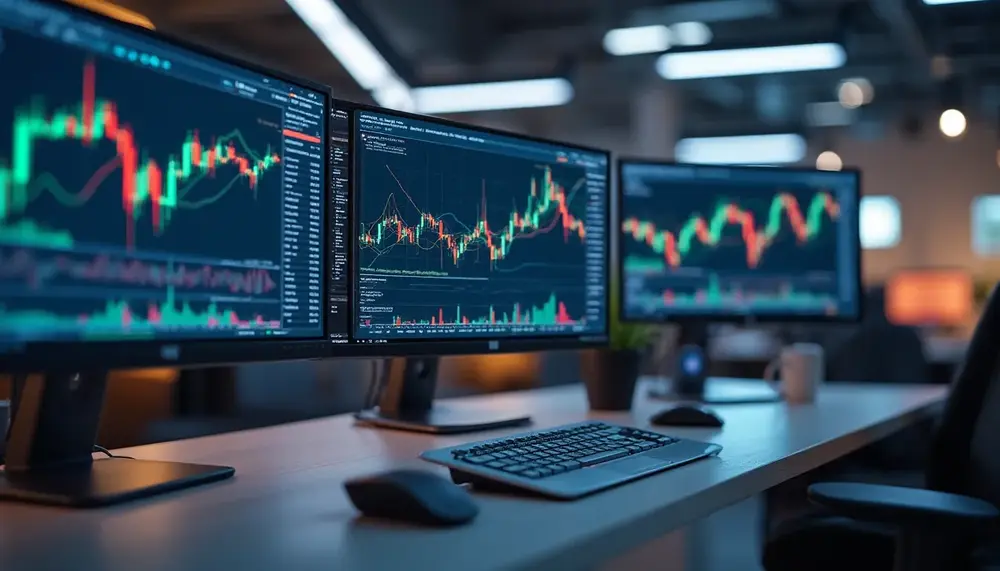Table of Contents:
Introduction: Decoding Trading Bots and Their Purpose
Trading bots—those elusive digital assistants—have rapidly shifted from obscure tools for tech-savvy traders to mainstream solutions shaping how people interact with financial markets. But what’s really behind the curtain? These bots aren’t just about speed or relentless 24/7 operation; their real purpose is to transform how strategies are executed, risk is managed, and opportunities are captured, often in ways that manual trading simply can’t match.
Imagine a world where market data is processed in milliseconds, patterns are detected before most humans even notice, and decisions are made with unwavering discipline. That’s the core promise of trading bots. They don’t just automate; they elevate trading by removing emotion, reducing reaction time, and allowing for complex strategies that would be nearly impossible to execute by hand. The real intrigue lies in how these bots bridge the gap between theoretical models and practical, real-world trading—delivering a blend of precision and adaptability that’s hard to rival.
As technology evolves, the role of trading bots expands, touching everything from cryptocurrencies to traditional stocks. Their purpose isn’t just to save time; it’s to empower traders—novices and professionals alike—to implement strategies with a level of consistency and sophistication that’s reshaping the entire landscape of investing.
Core Definition: What Exactly Is a Trading Bot?
Trading bots are, at their core, specialized software programs designed to autonomously execute trades on financial markets. Unlike simple automation scripts, these bots follow a set of predefined rules and sophisticated algorithms that can range from basic price triggers to complex, multi-layered strategies. They act as tireless agents, scanning vast amounts of market data, identifying opportunities, and placing buy or sell orders without human intervention.
What sets a trading bot apart from manual trading is its ability to operate with unwavering consistency and at a speed that no human could ever match. A bot is typically connected to a trading platform via an API, granting it direct access to market data and the ability to execute trades in real time. This direct integration allows for seamless and immediate responses to market changes, which is crucial in volatile environments.
Most trading bots are highly customizable. Users can define their own strategies, set risk parameters, and even adjust the bot’s behavior based on changing market conditions. Some advanced bots incorporate elements of machine learning or artificial intelligence, enabling them to adapt and refine their strategies over time. However, the majority of bots on the market rely on straightforward, rule-based logic that is transparent and easy to audit.
In essence, a trading bot is not just a tool for automation—it’s a digital trader, operating tirelessly and methodically, designed to execute strategies with a level of discipline and precision that is often out of reach for even the most experienced human investors.
How Trading Bots Operate: From Market Data to Automated Trading
Trading bots function through a well-orchestrated sequence of steps that turn raw market data into actionable trades. It all starts with relentless data collection—bots continuously pull live price feeds, trading volumes, and sometimes even order book snapshots from exchanges. This real-time data stream is the fuel for their decision-making engines.
- Signal Generation: Sophisticated algorithms sift through the incoming data, hunting for specific patterns or anomalies. These might include technical indicators like moving averages, RSI, or even custom-built triggers unique to a particular strategy.
- Strategy Execution: Once a signal is detected, the bot checks its programmed rules. If the criteria match—say, a price crosses a moving average or a volume spike occurs—the bot immediately prepares to act. This process is lightning-fast, often happening in milliseconds.
- Order Placement: The bot sends trade instructions directly to the exchange via secure APIs. It can place market orders, limit orders, or even more complex conditional orders, depending on its configuration and the exchange’s capabilities.
- Risk Management: Advanced bots incorporate risk controls, such as stop-losses, take-profits, or dynamic position sizing. These features help limit losses and lock in gains, adapting on the fly as market conditions shift.
- Continuous Monitoring: The process doesn’t stop after a trade. Bots monitor open positions, adjust parameters if needed, and stand ready to close trades or reverse course as new data arrives.
What’s truly remarkable is the relentless pace and objectivity with which these bots operate. They don’t get tired, second-guess themselves, or miss opportunities due to hesitation. Instead, they execute strategies with mechanical precision, providing a level of consistency that’s tough to achieve through manual trading alone.
Real-Life Example: How a Crypto Trading Bot Executes a Strategy
Let’s get hands-on with a concrete scenario: a crypto trading bot running a momentum-based strategy on Bitcoin. Here’s how it plays out in practice, step by step, revealing the real nuts and bolts behind the scenes.
- Initial Setup: The user configures the bot to monitor Bitcoin’s price and trading volume on a specific exchange. Parameters are set: if Bitcoin’s price rises by more than 2% within 30 minutes and volume spikes above a certain threshold, the bot should buy.
- Trigger Detection: The bot constantly scans live data. Suddenly, Bitcoin’s price jumps 2.3% in just 25 minutes, and volume soars past the pre-set limit. The bot’s logic is triggered—no hesitation, no second-guessing.
- Order Execution: The bot immediately places a buy order for the predefined amount of Bitcoin. It doesn’t wait for confirmation from the user, ensuring the trade happens at the earliest possible moment.
- Dynamic Adjustment: After the purchase, the bot keeps monitoring. If the price continues to climb, it trails the stop-loss upward, protecting profits. If the price reverses and drops by 1.5% from the peak, the bot sells automatically, locking in gains or limiting losses.
- Reporting and Logging: Every action—buy, sell, adjustment—is logged and summarized for the user. This transparency lets the trader review performance, tweak parameters, and refine the strategy for next time.
In this real-world example, the bot acts as a disciplined executor, sticking to the rules without emotional interference. It reacts to fast-moving markets in a way that would be nearly impossible for a human to match, especially at odd hours or during periods of high volatility.
Applications Across Markets: Where Trading Bots Excel
Trading bots have carved out specialized roles across a surprising variety of financial markets, each with its own unique quirks and opportunities. Their adaptability is what really sets them apart, allowing them to thrive in environments that demand speed, precision, and constant vigilance.
- Cryptocurrency Markets: Bots are especially dominant here due to the 24/7 nature and high volatility. They excel at exploiting arbitrage opportunities between exchanges, managing liquidity, and executing high-frequency trades that would be impossible for a human to track around the clock.
- Stock Exchanges: In traditional equity markets, bots shine in executing large volumes of trades without causing market disruption. They’re often used for algorithmic trading, portfolio rebalancing, and even market making, where they provide continuous buy and sell quotes to enhance liquidity.
- Forex (Foreign Exchange): The sheer size and liquidity of forex markets make them ideal for bots that implement strategies like scalping, trend following, or hedging. These bots can react to economic news releases and global events faster than any manual trader could.
- Commodities and Derivatives: Bots in these markets help manage complex hedging strategies, optimize futures contracts, and respond to rapid shifts in supply and demand. Their ability to analyze multiple variables—like weather data or geopolitical news—gives them an edge in anticipating price swings.
Across all these arenas, trading bots stand out by executing nuanced strategies that require relentless monitoring and split-second timing. Their success isn’t just about speed; it’s about their capacity to juggle massive datasets, adjust to changing conditions, and do so with a level of discipline that’s, frankly, hard to beat.
Popular Trading Strategies Deployed by Bots
Popular trading strategies implemented by bots go far beyond basic buy-low-sell-high logic. These strategies are meticulously engineered to exploit specific market inefficiencies or capitalize on predictable behaviors, often in ways that manual traders simply can’t replicate.
- Grid Trading: This approach involves placing a series of buy and sell orders at preset intervals above and below a set price. The bot profits from market fluctuations within a defined range, automatically buying low and selling high as the price oscillates.
- Arbitrage: Bots scan multiple exchanges or markets for price discrepancies of the same asset. When a difference is detected, the bot simultaneously buys low on one platform and sells high on another, pocketing the spread. This is especially common in cryptocurrency markets where price gaps can be significant.
- Momentum Trading: Here, bots jump into positions when they detect strong price trends or surges in trading volume. They ride the wave of momentum, aiming to exit before the trend reverses. Speed and timing are crucial, and bots are programmed to react instantly to these shifts.
- Mean Reversion: This strategy assumes that prices will eventually revert to their historical average. Bots monitor for deviations from the mean and execute trades that bet on a return to normalcy, often capitalizing on overreactions or corrections.
- Market Making: Bots continuously place buy and sell orders to provide liquidity. By profiting from the bid-ask spread, they help stabilize markets and can generate steady, albeit small, returns over time.
- Scalping: This ultra-short-term strategy involves making dozens or even hundreds of trades in a single day, each aiming for tiny profits. Bots excel at this because they can process information and execute orders far faster than any human could hope to.
Each of these strategies can be tailored to specific market conditions and risk profiles, making trading bots a flexible tool for both conservative and aggressive investors. The real art lies in selecting and fine-tuning the right approach for the current market climate.
Advantages for Investors: Maximizing Efficiency Through Automation
Automation through trading bots gives investors a set of distinct advantages that can’t be easily replicated by manual trading or traditional portfolio management. These benefits are especially apparent when it comes to maximizing efficiency and squeezing the most out of every market opportunity.
- Multi-Asset Management: Bots can monitor and trade across dozens of assets or markets simultaneously, something a human would struggle to juggle without missing signals or making costly mistakes.
- Backtesting and Optimization: Investors can test strategies on historical data before risking real capital. This means fewer surprises and a better understanding of how a strategy might perform under different market conditions.
- Consistent Execution: Automated systems stick to the plan, no matter what. There’s no hesitation or deviation due to fear, greed, or fatigue—just pure, systematic action.
- Scalability: Bots make it possible to scale up operations quickly. Whether you’re managing a handful of trades or thousands, automation ensures that performance doesn’t degrade as volume increases.
- Custom Alerts and Adaptive Controls: Many bots offer real-time notifications and the ability to tweak parameters on the fly, giving investors more control and insight without requiring constant supervision.
In short, automation lets investors leverage both time and technology, opening doors to strategies and efficiencies that would otherwise be out of reach. For those seeking to optimize every aspect of their trading process, the edge provided by trading bots is hard to ignore.
Potential Risks and Limitations of Relying on Trading Bots
Relying on trading bots introduces a unique set of risks and limitations that can catch even seasoned investors off guard. While automation promises efficiency, it also opens the door to challenges that are often underestimated.
- Algorithmic Blind Spots: Bots operate strictly within their programmed logic. If market conditions shift unexpectedly or a black swan event occurs, bots may continue executing trades based on outdated assumptions, leading to rapid losses.
- Technical Failures: Server outages, connectivity issues, or bugs in the bot’s code can result in missed trades, duplicated orders, or even unintended market exposure. These technical hiccups can be costly, especially in fast-moving markets.
- Security Vulnerabilities: Granting bots API access to trading accounts creates potential attack vectors. If credentials are compromised, malicious actors could gain control over funds, making robust security practices absolutely essential.
- Over-Optimization: Some investors fall into the trap of overfitting strategies to historical data. Bots may perform brilliantly in backtests but fail miserably in live markets, where conditions rarely mirror the past.
- Regulatory Uncertainty: Automated trading is subject to evolving regulations. Sudden changes in legal frameworks or exchange policies can render certain strategies non-compliant or even illegal overnight.
- Lack of Human Judgment: Bots lack intuition and the ability to interpret news, rumors, or sudden market sentiment shifts. This absence of qualitative analysis can result in missed warning signs or poorly timed trades.
Understanding these limitations is crucial for anyone considering automated trading. Without proper safeguards, oversight, and realistic expectations, the risks can easily outweigh the potential rewards.
The Role of Artificial Intelligence and Machine Learning in Advanced Bots
Artificial intelligence (AI) and machine learning (ML) are game-changers in the world of advanced trading bots, pushing far beyond static rule-based systems. These technologies empower bots to analyze complex, non-linear relationships in market data, adapt to evolving conditions, and even uncover patterns invisible to traditional algorithms.
- Pattern Recognition: AI-driven bots can process massive datasets, identifying subtle correlations or anomalies that would elude human analysts. For example, they might detect shifts in market sentiment by analyzing news headlines, social media, or alternative data sources.
- Adaptive Learning: Machine learning models enable bots to refine their strategies over time. By continuously ingesting new data, these bots can adjust parameters, recognize when a strategy is losing effectiveness, and pivot to more profitable approaches—sometimes without manual intervention.
- Predictive Analytics: Advanced bots leverage ML techniques like regression, classification, or neural networks to forecast price movements or volatility. This predictive edge can give traders a crucial advantage, especially in fast-moving or unpredictable markets.
- Risk Assessment: AI can dynamically assess risk by modeling the probability of extreme events or by simulating thousands of potential market scenarios. This helps bots make smarter decisions about position sizing and exposure, reducing the likelihood of catastrophic losses.
It’s worth noting that while AI-powered bots offer remarkable potential, they also demand robust data quality, computational resources, and careful oversight to avoid overfitting or unintended consequences. In the hands of skilled developers and data scientists, however, these advanced bots can unlock a level of market insight and adaptability that’s simply unattainable with conventional automation.
Practical Recommendations: Best Practices for Using Trading Bots
Effective use of trading bots hinges on a thoughtful, methodical approach. To truly benefit from automation while minimizing pitfalls, consider these best practices:
- Start with Demo Accounts: Before risking real funds, thoroughly test your bot’s logic and performance in a simulated environment. This allows you to identify bugs, unexpected behaviors, or market conditions that might trip up your strategy.
- Vet the Provider: Choose bots from reputable, transparent developers. Scrutinize user reviews, check for open-source code or independent audits, and avoid providers making unrealistic profit claims.
- Limit API Permissions: Only grant your bot the minimum necessary access. For example, disable withdrawal rights to prevent unauthorized fund transfers if your API keys are ever compromised.
- Document Your Strategy: Keep detailed records of your bot’s parameters, logic, and any changes made over time. This documentation helps with troubleshooting and refining your approach as markets evolve.
- Monitor Regularly: Even the most robust bots require periodic oversight. Set up alerts for abnormal activity and review performance metrics frequently to catch issues early.
- Stay Informed on Regulations: Keep up with legal developments affecting automated trading in your jurisdiction. This ensures your strategies remain compliant and reduces the risk of sudden disruptions.
- Prepare for the Unexpected: Have contingency plans for technical failures, market anomalies, or exchange outages. This might include manual override procedures or backup communication channels.
By combining technical diligence with disciplined oversight, you’ll maximize the benefits of trading bots while steering clear of common pitfalls that trip up less prepared investors.
Summary: Key Takeaways for Smart Use of Trading Bots
Smart use of trading bots demands more than just technical know-how—it requires a strategic mindset and a willingness to adapt as technology and markets evolve.
- Continuous learning is essential; the most successful bot users stay curious, regularly updating their knowledge as new algorithms, regulatory changes, and market structures emerge.
- Collaborating with other traders or participating in online communities can provide valuable insights and help uncover hidden pitfalls or emerging best practices.
- Integrating trading bots into a broader investment plan—rather than relying on them as a sole strategy—often leads to more resilient, diversified portfolios.
- Embracing transparency, both in the bot’s code and in reporting, fosters trust and allows for more effective troubleshooting and optimization.
- Lastly, ethical considerations matter: responsible bot deployment respects market integrity and avoids manipulative tactics that could lead to legal or reputational consequences.
Approaching trading bots with a blend of caution, curiosity, and ethical awareness sets the stage for long-term, sustainable success in automated investing.
Experiences and Opinions
Many users find trading bots easy to set up. They appreciate the automation aspect, which allows trades to be executed without constant monitoring. Bots can operate 24/7, making them ideal for markets that never sleep. This feature appeals particularly to traders with busy schedules.
However, not all experiences are positive. Some users report technical glitches that disrupt trading. These issues may lead to missed opportunities or unintentional losses. A common problem is the complexity of configuring bots for optimal performance. Many traders feel overwhelmed by the available settings.
Cost Concerns
Costs associated with trading bots vary widely. Basic bots may offer free versions, but premium features often come at a price. Users highlight that these costs can add up quickly, especially if multiple bots are used. A frequent complaint involves hidden fees that can eat into profits.
Performance and Profitability
Performance varies. While some users claim substantial profits, others report minimal gains. The effectiveness of a trading bot often depends on market conditions and the chosen strategy. Many traders believe that a bot can optimize profitable trades but caution against relying solely on automation.
In discussions on platforms like Growlonix, users share mixed reviews about profitability. Some suggest combining bot trading with manual oversight for better results. This hybrid approach seems to yield more consistent profits.
Security Issues
Security is a significant concern among users. Many traders worry about the safety of their funds when using bots. Reports of hacking incidents have heightened these fears. Users recommend choosing bots with robust security features and positive reviews regarding safety.
In conclusion, trading bots present both opportunities and challenges. They can simplify trading and potentially increase profits but come with risks. Traders must conduct thorough research before committing to a bot. Understanding the specific needs and market conditions can lead to a more successful trading experience.
FAQ about Trading Bots: Key Facts and Practical Insights
What exactly is a trading bot?
A trading bot is an automated software program designed to execute trades on financial markets according to predefined rules and algorithms. It analyzes real-time market data, identifies trading signals, and places buy or sell orders without human intervention.
How do trading bots work in practice?
Trading bots operate by constantly monitoring live market data, running strategy algorithms, and executing trades based on specific criteria. They are typically connected to exchanges via APIs, allowing them to act quickly when market opportunities arise, and often include risk controls and adaptive behaviors.
What types of trading strategies do bots use?
Trading bots deploy a wide range of strategies, including grid trading, arbitrage, momentum trading, mean reversion, market making, and scalping. These strategies are chosen and optimized to suit different market conditions and risk profiles.
What are the main advantages of using trading bots?
Trading bots offer benefits such as 24/7 operation, rapid execution, reduced emotional errors, and the ability to manage multiple assets simultaneously. They can backtest strategies, ensure consistent execution, and significantly save investors’ time.
What should investors watch out for when using trading bots?
Investors should be aware of risks like technical failures, security vulnerabilities, over-optimization, and regulatory changes. It's essential to test bots thoroughly, choose reputable providers, limit API permissions, and regularly monitor performance to mitigate potential losses.











